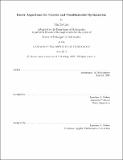Faster algorithms for convex and combinatorial optimization
Author(s)
Lee, Yin Tat
DownloadFull printable version (3.025Mb)
Other Contributors
Massachusetts Institute of Technology. Department of Mathematics.
Advisor
Jonathan A. Kelner.
Terms of use
Metadata
Show full item recordAbstract
In this thesis, we revisit three algorithmic techniques: sparsification, cutting and collapsing. We use them to obtain the following results on convex and combinatorial optimization: --Linear Programming: We obtain the first improvement to the running time for linear programming in 25 years. The convergence rate of this randomized algorithm nearly matches the universal barrier for interior point methods. As a corollary, we obtain the first ... time randomized algorithm for solving the maximum flow problem on directed graphs with m edges and n vertices. This improves upon the previous fastest running time of achieved over 15 years ago by Goldberg and Rao. --Maximum Flow Problem: We obtain one of the first almost-linear time randomized algorithms for approximating the maximum flow in undirected graphs. As a corollary, we improve the running time of a wide range of algorithms that use the computation of maximum flows as a subroutine. --Non-Smooth Convex Optimization: We obtain the first nearly-cubic time randomized algorithm for convex problems under the black box model. As a corollary, this implies a polynomially faster algorithm for three fundamental problems in computer science: submodular function minimization, matroid intersection, and semidefinite programming. --Graph Sparsification: We obtain the first almost-linear time randomized algorithm for spectrally approximating any graph by one with just a linear number of edges. This sparse graph approximately preserves all cut values of the original graph and is useful for solving a wide range of combinatorial problems. This algorithm improves all previous linear-sized constructions, which required at least quadratic time. --Numerical Linear Algebra: Multigrid is an efficient method for solving large-scale linear systems which arise from graphs in low dimensions. It has been used extensively for 30 years in scientific computing. Unlike the previous approaches that make assumptions on the graphs, we give the first generalization of the multigrid that provably solves Laplacian systems of any graphs in nearly-linear expected time.
Description
Thesis: Ph. D., Massachusetts Institute of Technology, Department of Mathematics, 2016. This electronic version was submitted by the student author. The certified thesis is available in the Institute Archives and Special Collections. Cataloged from student-submitted PDF version of thesis. Includes bibliographical references (pages 443-458).
Date issued
2016Department
Massachusetts Institute of Technology. Department of MathematicsPublisher
Massachusetts Institute of Technology
Keywords
Mathematics.